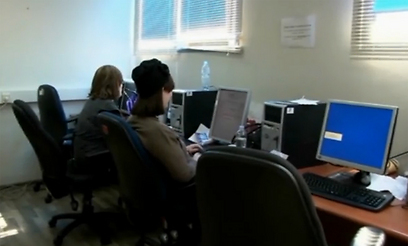Survey commissioned by Kol Chai Radio reveals only 46% of ultra-Orthodox men work for a living compared to 76% of women; in two-thirds of haredi households, total income is lower than one Israeli worker’s average salary.
The monthly income of 63% of households in Israel’s ultra-Orthodox sector is less than NIS 8,000 (about $2,081), according to figures released by the Seker Kahalacha research institute. One of the reasons is that 54% of men in haredi households do not take part in supporting their families.
The survey commissioned by haredi and national-religious radio station Kol Chai Radio.
According to the figures, only 46% of haredi men work for a living (83% as hired employees and 17% self-employed), compared to 76% of haredi women (57% as full-time hired workers, 31% part-time and 12% self-employed).
In 42% of the families, the woman is the only breadwinner, in 34% both the husband and the wife work, in 12% both don’t work, and in the remaining 12% only the man works.
As a result, 16% of the families earn up to NIS 4,000 a month, and 47% earn between 4,000 and 8,000 a month – meaning that in two-thirds of haredi households both the man and woman’s income is lower than the average salary for one worker in the Israeli economy.
Only 1% of households earn more than NIS 20,000
Twenty-seven percent of haredi households earn NIS 8,000 to 12,000, 9% earn NIS 12,000 to 20,000, and only 1% earn more than NIS 20,000.
As expected, the survey’s figures point to direct link between the couple’s participation in the labor market and the family’s level of income, with the men’s influence being higher. Surprisingly, in households with a monthly income of more than NIS 20,000, 40% of the men and 30% of the women don’t work.

The survey was conducted by the Seker Kahalacha research institute led by Dr. Ron Kedem and included 1,000 haredi respondents, men and women, in more than 50 communities – all adult and married. The sample included respondents from the three main haredi factions: Hasidic, Lithuanian and Sephardic. The maximal sampling error was 2.5%.
Lea Bloy, a strategic and Seker Kahalacha’s research manager, stressed that the institute is the only one which knows how to analyze the haredi public and its different factions, and therefore provides reliable figures.
“In this survey, for example, an overrepresentation of Hasidic Jews could create a misleading picture, according to which more haredi men work and the salary is higher,” she said. “We also reached a formula on the question who is a haredi, which directly affects the sample’s quality, by cross-checking four different questions.”
As reported by Ynetnews
